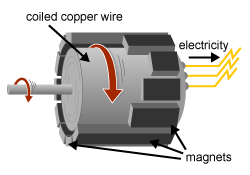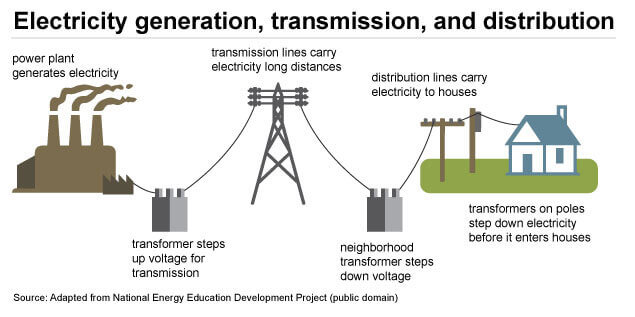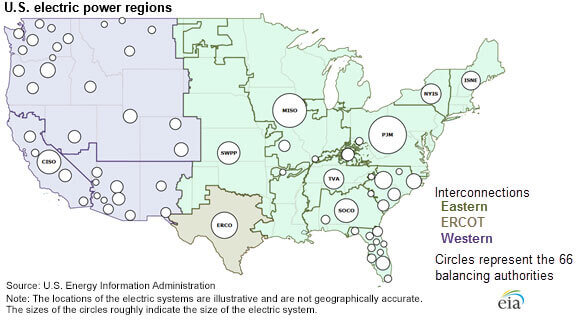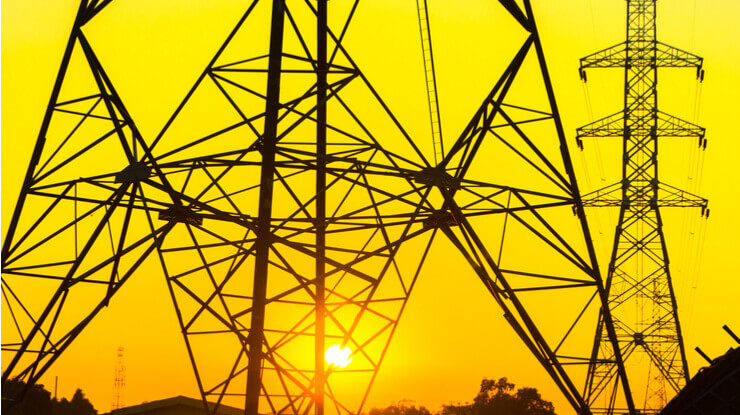America’s demand for electricity is huge, totaling 18% of the world’s electricity consumption in 2015. We take for granted that electricity will be there when we turn on the lights or crank up the air conditioner. We can’t imagine life without it. But, have you ever wondered how electricity is made, or where it comes from, or how we get it the instant we want it?
Beginning in 1879, electricity was first sold in the United States by the California Electric Light Company in San Francisco which produced and sold enough electricity to run about 20 electric lights. Since then the use of electricity has grown exponentially. Fast forward to 2016 and Americans consumed about 3.85 trillion kilowatthours (kWh) of electricity according to the U.S. Energy Information Administration. In this post we cover the basics about what powers this huge amount of consumption, the sources of electricity in the US, and the role of deregulation.
How is Electricity Made?
Electricity is a secondary source of energy meaning it takes another primary source of energy to create it. Large power generation plants use turbines to drive electricity generators that create electricity. There are several different types of turbines including steam turbines, gas combustion turbines, water turbines, and wind turbines. The turbines convert the kinetic energy of a moving fluid (liquid or gas) or wind into mechanical energy. The turbines are fueled by a primary source of energy such as coal, natural gas, nuclear energy, hydropower, or wind energy. This fuel is used to move the blades of the turbine which are mounted on a shaft connected to a generator.

Where Does My Electricity Come From?
According to the EIA, in 2016 65% of electricity generation in the United States was from fossil fuels (coal, natural gas), 20% was from nuclear, and 15% was from renewable resources.
Fossil Fuels
Natural gas was the primary fuel source for 34% of electricity generated in 2016. Natural gas fuels steam turbines as well as gas turbines. Coal was the second-largest energy source for electricity generation at 30%. Most coal-fired power plants burn coal to fuel steam turbines. Petroleum fueled generation amounted to 1% of electricity produced in 2016.
Nuclear
Nuclear power plants produced 20% of the electricity generated in 2016. Nuclear power plants make electricity with nuclear fission to create steam to fuel steam turbines.
Renewables
Hydropower facilities produced about 7% of the nation’s electricity in 2016. Hydropower uses flowing water to spin a turbine connected to a generator. Most hydropower is at large facilities (dams) built by the federal government.
Wind power uses wind energy to spin wind turbines to generate electricity. Wind power accounted for about 6% of electricity generated in 2016 and has increased significantly in recent years. Wind farms in Texas, Iowa, Oklahoma, Kansas, and California contributed approximately 55% of the total wind electricity generation measured in the United States in 2016 with Texas being the largest contributor. In fact, the Houston Chronicle reports that wind power now surpasses coal power in Texas.
Biomass, solar, and geothermal sources combined comprised 3% of the U.S. electricity production in 2016. Utility scale wind power and solar power generation facilities are generally owned by large public or private energy generation companies.
How Is Electricity Delivered?
After electricity is generated at a power plant facility, it moves through a complex system of substations, transformers, transmission lines, and distribution lines (otherwise known as the power grid) that connect electricity generators to consumers. Initially these grids operated as thousands of individual systems, but, after World War II, utilities began to connect their grids to each other making it easier to share electricity generation and provide more reliable power.

Today local electric grids owned by investor-owned utilities, public-owned utilities and cooperatives, independent power producers, and the federal government are all interconnected to form large networks of electric systems. In the Lower 48 states there are three main interconnections which operate independently from each other:

- The Eastern Interconnection – the area east of the Rocky Mountains & a portion of the Texas panhandle.
- The Western Interconnection – the area west of the Rocky Mountains
- ERCOT (The Electric Reliability Council of Texas) – most of Texas
Stability of the electric grid means that electricity demand always meets electricity supply. This requires coordination and planning of several different entities operating along the grid. These interconnected systems are managed by Regional Transmission Operators (RTOs) and/or Independent System Operators (ISOs) which operate the grid in accordance with reliability standards developed by the North American Electric Reliability Corporation (NERC).
Entities such as PJM, Southwest Power Pool, and ERCOT are RTO/ISOs that operate a respective area of the interconnection in which they are located. Imagine trying to balance the demand of electricity with the generation of electricity in real time and make sure everyone has enough power when they need it. That is the very important job of an RTO/ISO.
What is the Role of an Electricity Provider a Deregulated Market?
In deregulated electricity markets, the supply of electricity is available for customers to buy from their choice of many qualified electricity providers. Each state’s public utility commission has a specific set of rules and qualifications that a retail electricity provider must meet in order to be certified to sell electricity to a consumer.
Deregulation creates an open market for the purchase of electricity generation, and electricity suppliers purchase the generation on behalf of their customers. In theory, having open markets and competition drives down cost. Has deregulation actually done this? The answer is a qualified yes, and some states have had more success than others. In general, customers like having the ability to choose who provides their electricity and how their electricity is made.
What is the Role of an Electric Utility in a Deregulated Market?
The electric utility in a deregulated market provides reliable delivery of electricity to every customer in their service area regardless of who supplies their electricity. In some deregulated states the utility offers customers a standard service offer (SSO) for the supply of electricity for those customers who do not choose to purchase their electricity from an authorized retail electricity supplier. In other deregulated states, utilities have a designated provider of last resort (POLR) to supply the electricity if they do not select another authorized supplier.
The utility’s delivery charge on the electric bill is not open to competition and will be the same for everyone (depending on their rate class) served by that utility. The rate is set and regulated by the state’s public utility commission. The delivery rate represents a variety of approved tariffs that pay for the distribution (poles & wires), maintenance of poles & wires, meters, and measurement of electricity to your home or business.
Learn more about the difference between an electric utility and an electricity provider >>>
From the Source to the Bulb
Getting electricity from the generation source, across the grid, and into your home or business is tremendously complicated and one of the modern marvels of the last 100+ years. From generation, transmission, and distribution (the ‘flow‘) to usage and billing (the ‘dough‘), electricity impacts every part of our lives and economy. Understanding deregulation and the various processes involved will help you navigate your options for purchasing electricity and finding the best electricity deal possible.
